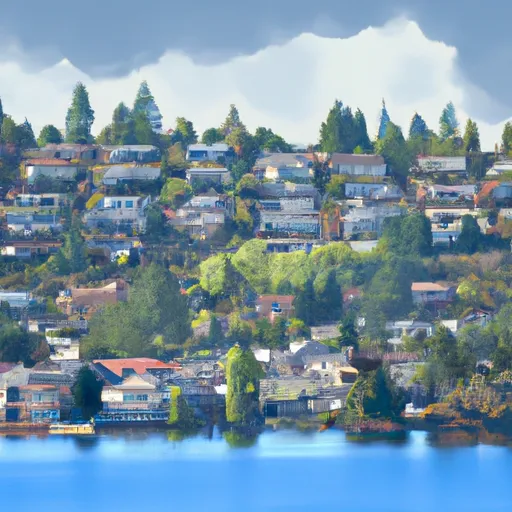-
 Snoflo Premium
Snoflo Premium
Get unlimited access to all our content
With no Ad interruptions! - Start Your Free Trial Login with existing account
Upper-Lake
Eden Index
Climate
10.0
•
Recreation
6.1
•
Community
2.8
•
Safeguard
6.8/10

Upper Lake is a small unincorporated community located in Lake County, California. Situated in the northern part of the state, Upper Lake experiences a Mediterranean climate characterized by hot, dry summers and mild, wet winters. Average temperatures range from 40°F in winter to 90°F in summer.
The region's hydrology is primarily influenced by Clear Lake, the largest natural freshwater lake entirely situated in California. Located nearby, this hydrologic feature enhances the area's climate by reducing temperature extremes and providing moisture. Clear Lake is a popular destination for fishing and water sports such as boating and swimming. The lake is home to various fish species, including bass and catfish, making it a haven for anglers.
Aside from Clear Lake, Upper Lake also offers a range of outdoor recreational opportunities. The nearby Mendocino National Forest provides ample opportunities for hiking, camping, and wildlife viewing. The forest boasts scenic trails, serene camping spots, and an abundance of diverse flora and fauna. Outdoor enthusiasts can also explore the Cache Creek Wilderness, which offers hiking, horseback riding, and trail biking opportunities.
In summary, Upper Lake, California offers a Mediterranean climate, influenced by Clear Lake's hydrology. The region provides numerous outdoor recreational activities, including fishing, boating, hiking, camping, and wildlife viewing.
What is the Eden Index?
The Snoflo Eden Index serves as a comprehensive rating system for regions, evaluating their desirability through a holistic assessment of climate health, outdoor recreation opportunities, and natural disaster risk, acknowledging the profound impact of these factors on livability and well-being.
Climate Health Indicator (CHI): 10.0
Upper-Lake receives approximately
1063mm of rain per year,
with humidity levels near 63%
and air temperatures averaging around
14°C.
Upper-Lake has a plant hardyness factor of
8, meaning
plants and agriculture in this region tend to thrive here all year round.
By considering the ideal temperature range, reliable water supplies, clean air, and stable seasonal rain or snowpacks, the Climate Health Indicator (CHI) underscores the significance of a healthy climate as the foundation for quality living.
A healthy climate is paramount for ensuring a high quality of life and livability in a region, fostering both physical well-being and environmental harmony. This can be characterized by ideal temperatures, reliable access to water supplies, clean air, and consistent seasonal rain or snowpacks.
Weather Forecast
Streamflow Conditions
Lower Sacramento
Area Rivers
Lower Sacramento
Snowpack Depths
Lower Sacramento
Reservoir Storage Capacity
Lower Sacramento
Groundwater Levels
Recreational Opportunity Index (ROI): 6.1
The Recreational Opportunity Index (ROI) recognizes the value of outdoor recreational options, such as parks, hiking trails, camping sites, and fishing spots, while acknowledging that climate plays a pivotal role in ensuring the comfort and consistency of these experiences.
Access to outdoor recreational opportunities, encompassing activities such as parks, hiking, camping, and fishing, is crucial for overall well-being, and the climate plays a pivotal role in enabling and enhancing these experiences, ensuring that individuals can engage in nature-based activities comfortably and consistently.
Camping Areas
| Campground | Campsites | Reservations | Toilets | Showers | Elevation |
|---|---|---|---|---|---|
| Saddle Camp Loop | 9 | 4,522 ft | |||
| Middle Creek | 41 | 1,481 ft | |||
| Main Letts | 18 | 4,546 ft | |||
| Deer Valley | 13 | 3,616 ft | |||
| Mill Valley | 15 | 4,086 ft | |||
| Penny Pines | 10 | 3,688 ft | |||
| Spillway - Letts Lake | 9 | 4,496 ft | |||
| Cedar Camp | 6 | 4,262 ft | |||
| Stirrup - Letts Lake | 28 | 4,378 ft | |||
| Cow Mountain Rec Area Dispersed | None | 3,410 ft |
Nearby Fishing
Nearby Ski Areas
Catastrophe Safeguard Index (CSI):
The Catastrophe Safeguard Index (CSI) recognizes that natural disaster risk, encompassing floods, fires, hurricanes, and tornadoes, can drastically affect safety and the overall appeal of an area.
The level of natural disaster risk in a region significantly affects safety and the overall livability, with climate change amplifying these risks by potentially increasing the frequency and intensity of events like floods, fires, hurricanes, and tornadoes, thereby posing substantial challenges to community resilience and well-being.
Community Resilience Indicator (CRI): 2.8
The Community Resilience Indicator (CRI) recognizes that education, healthcare, and socioeconomics are crucial to the well-being of a region. The CRI acknowledges the profound impact of these elements on residents' overall quality of life. By evaluating educational resources, healthcare accessibility, and economic inclusivity, the index captures the essential aspects that contribute to a thriving community, fostering resident satisfaction, equity, and social cohesion.

